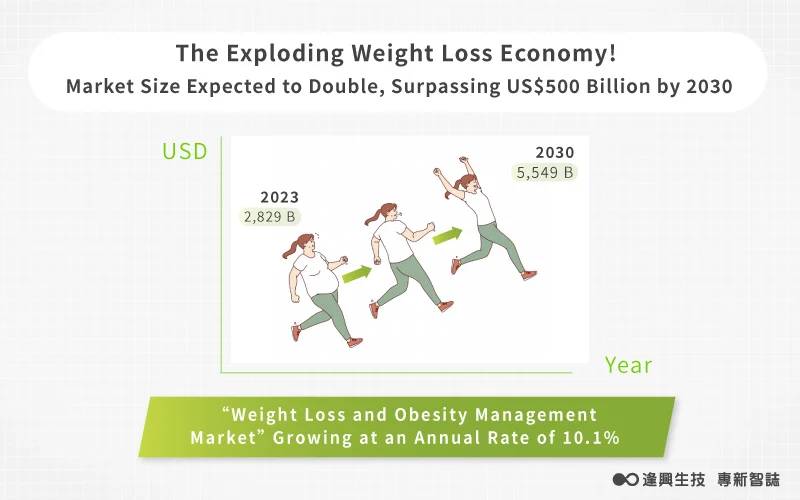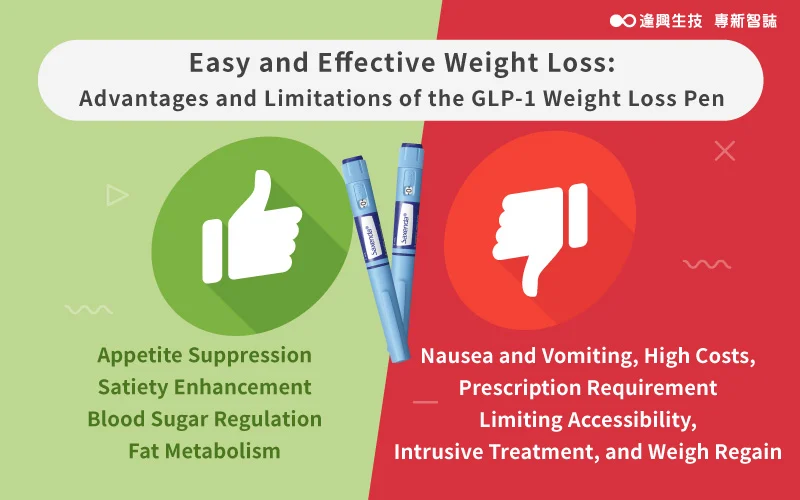
Ending Yo-Yo Dieting: The Edible Alternative to ‘Weight Loss Pen, Saxenda’ is Set to Transform the Health Market!

Written by: Nutritionist Maureen Chen
An Everlasting Demand for Weight Loss: From Low-Carb Diets to Medical Assistance
Combining diet control with exercise remains the golden rule for maintaining a healthy physique. Recent trends, such as low-carb diets and keto diets or the popular intermittent fasting, all aim to help people lose weight more effectively. The “Weight Loss and Obesity Management” market has seen unprecedented growth. Market data estimates the global market at $282.9 billion in 2023 with projections reaching $554.9 billion by 2030, reflecting an annual compound growth rate of 10.1%.[1]
To meet consumers’ desire for easy and quick results, the medical community has introduced innovative weight loss methods in recent years, ranging from non-invasive cryolipolysis to more aggressive weight loss surgeries. Among these, the “Weight Loss Pen, Saxenda” (a GLP-1 analog injection) stands out for its rapid and significant weight loss effects. Endorsed by celebrities like Elon Musk, it has quickly become a trending topic. Many consumers view the Weight Loss Pen as a “shortcut” to effortless weight management. But what makes it so effective for rapid weight loss? What is the mechanism behind it?

[1] Weight Loss and Obesity Management Market Forecasts to 2030
https://www.gii.tw/report/smrc1462651-weight-loss-obesity-management-market-forecasts.html?
How the Weight Loss Pen Works: GLP-1 and DPP-4 Mechanisms
The Weight Loss Pen (a GLP-1 analog injection) has gained significant attention for its impressive weight loss effects by mimicking and enhancing the body’s natural GLP-1 (glucagon-like peptide-1) functions.
How GLP-1 Supports Weight Loss
GLP-1 is a hormone secreted by the intestines after eating that triggers several mechanisms to promote weight loss:
- Appetite Suppression: Reduces hunger by acting on the brain’s satiety centers.
- Delayed Gastric Emptying: Prolongs the feeling of fullness by slowing stomach emptying.
- Blood Sugar Regulation: Enhances insulin sensitivity and reduces glucagon secretion to stabilize blood sugar levels.
- Fat Metabolism: Facilitates the breakdown of excess fat.
However, natural GLP-1 has a short lifespan in the body and is rapidly broken down by DPP-4 (dipeptidyl peptidase-4), limiting its effectiveness. The Weight Loss Pen addresses this by delivering GLP-1 analogs and using DPP-4 inhibitors to extend the hormone’s active duration, enhancing its effects. Traditionally, GLP-1 mechanisms were activated through injections. However, the introduction of oral alternatives now provides a more convenient option for those who prefer to avoid injections. Despite these advancements, Weight Loss Pen injections still come with certain limitations and side effects:
Weight Loss Pen Side Effects:
- Adverse Reactions: Common side effects include nausea, vomiting, and gastrointestinal discomfort.
- High Costs: The medication is expensive, making long-term use financially challenging.
- Convenience Issues: Requires a prescription and regular, precise dosing, which may be inconvenient.
- Sustainability Concerns: Weight regain is possible due to metabolic slowdown and compensatory eating after stopping treatment.
While the Weight Loss Pen leverages the GLP-1 mechanism to overcome many traditional weight loss challenges, its limitations still discourage some users. There remains a demand for a painless, low-risk, affordable, and convenient alternative. Oral solutions, such as capsules or jelly-type supplements that activate the GLP-1 mechanism, could provide a more accessible and user-friendly option.




